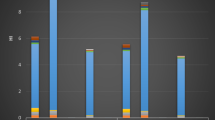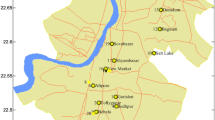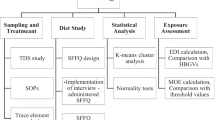Abstract
This study was designed to evaluate heavy metal status in commonly consumed foodstuffs collected from two divisional cities, viz., Chottogram and Mymensingh of Bangladesh and to assess potential human health risks through the consumption of those foodstuffs. A total of 90 food samples were analyzed for Cu, Zn, Ni, Pb, Mn, and Fe contents by an atomic absorption spectrophotometer. The calculated per capita per day dietary intakes of Cu and Mn from rice and Mn’s same value through spinach consumption in both cities were higher than the recommended daily allowances (RDA) for an adult human. Similarly, the computed daily metal intake (DMI) values of Pb for both males and females were also higher than the upper tolerable intake level (UTIL) through the consumption of rice collected from Mymensingh city. The average calculated hazard index (HI) values for males and females due to dietary intake of rice were 47.67 and 93.30 in Chottogram city and 97.98 and 192.04 in Mymensingh city, respectively. The present study identified rice as the most contaminated food item, followed by spinach, brinjal, and lentil. Still, dietary intakes of beef, broiler, and fish samples collected from both the cities were found as safe or less hazardous. Among the individual metals, Mn was the most dominant metal present in different foodstuffs collected from both the cities and contributed significant risk to the people. Finally, the study concluded that Bangladesh’s food consumption patterns should be changed and advised to incorporate more proteins in regular diet charts by reducing carbohydrates.




Similar content being viewed by others
Data Availability
The data that support the findings of this study are available on request from the corresponding author.
References
Akter M, Zakir HM, Sharmin S, Quadir QF, Mehrin S (2020) Heavy metal bioaccumulation pattern in edible tissues of different farmed fishes of Mymensingh area, Bangladesh and health risk assessment. Adv Res 21(4):44–55. https://doi.org/10.9734/air/2020/v21i430200
Al-Jassir MS, Shaker A, Khaliq MA (2005) Deposition of heavy metals on green leafy vegetables sold on roadsides of Riyadh City, Saudi Arabia. Bull Environ Contam Toxicol 75(5):1020–1027. https://doi.org/10.1007/s00128-005-0851-4
Alturiqi AS, Albedair LA (2012) Evaluation of some heavy metals in certain fish, meat and meat products in Saudi Arabian markets. Egypt J Aquat Res 38:45–49. https://doi.org/10.1016/j.ejar.2012.08.003
Ametepey ST, Cobbina SJ, Akpabey FJ, Duwiejuah AB, Abuntori ZN (2018) Health risk assessment and heavy metal contamination levels in vegetables from Tamale Metropolis, Ghana. Int J Food Contam 5:5. https://doi.org/10.1186/s40550-018-0067−0
Aysha MIJ, Zakir HM, Haque R, Quadir QF, Choudhury TR, Quraishi SB, Mollah MZI (2017) Health risk assessment for population via consumption of vegetables grown in soils artificially contaminated with arsenic. Arch Curr Res Int 10(3):1–12. https://doi.org/10.9734/acri/2017/37612
Banerjee D, Bairagi H, Mukhopadhyay S, Pal A, Bera D, Ray L (2010) Heavy metal contamination in fruits and vegetables in two districts of West Bengal, India. Elec J Environ Agril Food Chem 9(9):1423–1432
Bawiec P, Halabis M, Marzec Z, Kot A, Solski J, Gawel K (2014) Evaluation of chromium, nickel, iron and manganese content in wheat, flour, bran and selected baked products. Curr Issues Pharm Med Sci 27(2):71–75. https://doi.org/10.2478/cipms-2014-0016
BBS (2015) Health and morbidity status survey-2014. Bangladesh Bureau of Statistics, Statistics and Informatics Division, Ministry of Planning, Govt. of the People’s Republic of Bangladesh. www.bbs.gov.bd
Connie WB, Christine SR (2009) Handbook of clinical nutrition and aging, 2nd edn. Humana Press, New York
da Silva Tores EAF, Garbelotti ML, Neto JMM (2006) The application of hierarchical cluster analysis to the study of the composition of foods. Food Chem 99(3):622–629. https://doi.org/10.1016/j.foodchem.2005.08.032
El-Batrawy OA, El-Gammal MI, Mohamadein LI, Darwish DH, El-Moselhy KM (2018) Impact assessment of some heavy metals on tilapia fish, Oreochromis niloticus, in Burullus Lake, Egypt. J Basic Appl Zool 79:1–12. https://doi.org/10.1186/s41936-018-0028-4
FDA (2001) Dietary reference intakes for vitamin A, vitamin K, arsenic, boron, chromium, copper, iodine, iron, manganese, molybdenum, nickel, silicon, vanadium, and zinc. Report of the Panel on Micronutrients. National Academy Press, Washington, DC
Garcia-Rico L, Leyva-Perez J, Jara-Marini ME (2007) Content and daily intake of copper, zinc, lead, cadmium, and mercury from dietary supplements in Mexico. Food Chem Toxicol 45:1599–1605. https://doi.org/10.1016/j.fct.2007.02.027
Gergen I, Harmanescu M (2012) Application of principal component analysis in the pollution assessment with heavy metals of vegetable food chain in the old mining areas. Chem Cent J 6:156. https://doi.org/10.1186/1752-153X-6-156
Hammer Q, Harper DAT, Ryan PD (2001) Past: Paleontological statistics software package for education and data analysis. Palaeontol Electron 4(1):4. http://palaeo-electronica.org/2001_1/past/issue1_01.htm
Haque R, Zakir HM, Aysha MIJ, Mallick S, Rahman MS (2018) Heavy metal uptake pattern and potential human health risk through consumption of tomato grown in industrial contaminated soils. Asian J Adv Agric Res 5(4):1–11. https://doi.org/10.9734/AJAAR/2018/40169
HIES (2017) Preliminary report on household income and expenditure survey 2016. Bangladesh Bureau of Statistics, Ministry of Planning, Govt. of the People’s Republic of Bangladesh, Dhaka-1000, Bangladesh
Hossain MA, Zakir HM, Kumar D, Alam MS (2017) Quality and metallic pollution level in surface waters of an urban industrialized city: a case study of Chittagong city, Bangladesh. J Ind Safety Engg 4(2):9–18. https://doi.org/10.37591/joise.v4i2.1941
Ihedioha JN, Okoye COB, Onyechi UA (2014) Health risk assessment of zinc, chromium, and nickel from cow meat consumption in an urban Nigerian population. Int J Occup Environ Health 20(4):281–288. https://doi.org/10.1179/2049396714Y.0000000075
Ikem A, Egiebor NO (2005) Assessment of trace elements in canned fishes (mackerel, tuna, salmon, sardines and herrings) marketed in Georgia and Alabama (United States of America). J Food Comp Anal 18(8):771–787. https://doi.org/10.1016/j.jfca.2004.11.002
Inobeme A, Obigwa PA, Olori E, Eziukwu C, Bamigboye O (2018) Heavy metal contents of meats from Auchi, Edo State, Nigeria. Environ Res J 12(2–4):19–22
Islam F, Zakir HM, Rahman A, Sharmin S (2020) Impact of industrial wastewater irrigation on heavy metal deposition in farm soils of Bhalauka area, Bangladesh. J Geog Environ Earth Sci Int 24(3):19–31. https://doi.org/10.9734/JGEESI/2020/v24i330207
Iwegbue CMA, Nwajei GE, Iyoha EH (2008) Heavy metal residues of chicken meat and gizzard and turkey meat consumed in southern Nigeria. Bulg J Vet Med 11(4):275–280
Jafari A, Kamarehie B, Ghaderpoori M, Khoshnamvand N, Birjandi M (2018) The concentration data of heavy metals in Iranian grown and imported rice and human health hazard assessment. Data Brief 16:453–459. https://doi.org/10.1016/j.dib.2017.11.057
Khan S, Cao Q, Zheng YM, Huang YZ, Zhu YG (2008) Health risks of heavy metals in contaminated soils and food crops irrigated with wastewater in Bei**g, China. Environ Pollut 152:686–692. https://doi.org/10.1016/j.envpol.2007.06.056
Lamastra L, Suciu NA, Trevisan M (2018) Sewage sludge for sustainable agriculture: contaminants’ contents and potential use as fertilizer. Chem Biol Technol Agric 5:1–6. https://doi.org/10.1186/s40538-018-0122-3
Latif A, Bilal M, Asghar W, Azeem M, Ahmad MI, Abbas A, Ahmad MZ, Shahzad T (2018) Heavy metal accumulation in vegetables and assessment of their potential health risk. J Environ Anal Chem 5(1):1–7. https://doi.org/10.4172/2380-2391.1000234
Leshe S, Tessema M (2014) Determination of levels of essential and toxic heavy metals in lentil (Lens culinaris Medik) by flame atomic absorption spectroscopy. Afr J Chem Edu 4(4):16–34
Llobet JM, Falco G, Casas C, Teixido A, Domingo JL (2003) Concentration of arsenic, cadmium, mercury, and lead in common foods and estimated daily intake by children, adolescents, adults, and seniors of Catalonia, Spain. J Agril Food Chem 51(3):838–842. https://doi.org/10.1021/jf020734q
Ludajic GI, Pezo LL, Filipovic NK, Filipovic JN (2015) The content of essential and toxic elements in wheat bran and flour. Hemijska Ind 69(4):417–423. https://doi.org/10.2298/HEMIND140322056L
Nkansah MA, Ansah JK (2014) Determination of Cd, Hg, As, Cr and Pb levels in meat from the Kumasi Central Abattoir. Int J Sci Res Pub 4(8):1–4
Noor N, Zutshi B (2016) Bioaccumulation of trace metals in tissues of rohu fish for environmental risk assessment. J Water Res Protect 8:472–481. https://doi.org/10.4236/jwarp.2016.84040
Ondo JA, Biyogo RM, Eba F, Prudent P, Fotio D, Ollui-Mboulou M, Omva-Zue J (2013) Accumulation of soil-borne aluminium, iron, manganese and zinc in plants cultivated in the region of Moanda (Gabon) and nutritional characteristics of the edible parts harvested. J Sci Food Agric 93(10):2549–2555. https://doi.org/10.1002/jsfa.6074
Paul BN, Chanda S, Sridhar N, Saha GS, Giri SS (2016) Proximate, mineral and vitamin contents of Indian major carp. Indian J Anim Nutr 33(1):102–107. https://doi.org/10.5958/2231-6744.2016.00018.9
Pilon M, Cohu CM, Ravet K, Abdel-Ghany SE, Gaymard F (2009) Essential transition metal homeostasis in plants. Curr Opin Plant Biol 12(3):347–357. https://doi.org/10.1016/j.pbi.2009.04.011
Radwan MA, Salama AK (2006) Market basket survey for some heavy metals in Egyptian fruits and vegetables. Food Chem Toxicol 44(8):1273–1278. https://doi.org/10.1016/j.fct.2006.02.004
Rana M, Bakali B, Mia MY, Zakir HM (2014) Physico-chemical properties of effluents discharged from different industries of Gazipur, Bangladesh and its suitability for agricultural land. J Environ Sci Nat Resour 7(1):157–167. https://doi.org/10.3329/jesnr.v7i1.22165
Sarbu C, Pop HF (2005) Principal component analysis versus fuzzy principal component analysis. A case study, the quality of Danube water 1985–1996. Talanta 65:1215–1220. https://doi.org/10.1016/j.talanta.2004.08.047
Sarker MS, Quadir QF, Zakir HM, Nazneen T, Rahman A (2017) Evaluation of commonly used fertilizers, fish and poultry feeds as potential sources of heavy metals contamination in food. Asian Australas J Food Safety Security 1(1):74–81
Sharmin S, Mia J, Miah MS, Zakir HM (2020) Hydrogeochemistry and heavy metal contamination in groundwaters of Dhaka metropolitan city, Bangladesh: Assessment of human health impact. HydroRes 3:106–117. https://doi.org/10.1016/j.hydres.2020.10.003
Shovon MNH, Majumdar BC, Rahman Z (2017) Heavy metals (lead, cadmium and nickel) concentration in different organs of three commonly consumed fishes in Bangladesh. Fish Aqua J 8(3):1–5. https://doi.org/10.4172/2150-3508.1000207
Singh D, Chhonkar PK, Pandey RN (1999) Soil, plant and water analysis: a method manual. IARI, New Delhi, India
US EPA (2010) Human Health Risk Assessment: Risk-Based Concentration Table. http://www.epa.gov/reg3hwmd/risk/human/rb-concentration_table/Generic_Tables/html. Accessed 25 Dec 2019
Zakir HM, Sumi SA, Sharmin S, Mohiuddin KM, Kaysar S (2015) Heavy metal contamination in surface soils of some industrial areas of Gazipur, Bangladesh. J Chem Biol Phy Sci 5(2):2191–2206
Zakir HM, Islam MM, Hossain MS (2016) Impact of urbanization and industrialization on irrigation water quality of a canal-a case study of Tongi canal Bangladesh. Adv Environ Res 5(2):109–123. https://doi.org/10.12989/aer.2016.5.2.109
Zakir HM, Islam MM, Hossain MS (2017) Heavy metal contents in sediments of an urban industrialized area: a case study of Tongi canal, Bangladesh. Asian J Water Environ Pollut 14(1):59–68. https://doi.org/10.3233/AJW-170007
Zakir HM, Aysha MIJ, Mallick S, Sharmin S, Quadir QF, Hossain MA (2018) Heavy metals and major nutrients accumulation pattern in spinach grown in farm and industrial contaminated soils and health risk assessment. Arch Agric Environ Sci 3(1):95–102. https://doi.org/10.26832/24566632.2018.0301015
Zakir HM, Islam F, Quadir QF, Rahman A (2020a) Metallic health risk through consumption of different rice varieties cultivated in industrial wastewater irrigated farmers’ fields of Bhaluka area, Bangladesh. Curr J App Sci Technol 39(11):76–91. https://doi.org/10.9734/CJAST/2020/v39i1130650
Zakir HM, Sharmin S, Akter A, Rahman MS (2020b) Assessment of health risk of heavy metals and water quality indices for irrigation and drinking suitability of waters: a case study of Jamalpur Sadar area, Bangladesh. Environ Adv 2:100005. https://doi.org/10.1016/j.envadv.2020.100005
Funding
This work was financially supported by the Grants on Advanced Research in Education (GARE), Ministry of Education, Government of the People's Republic of Bangladesh, Dhaka-1000, Bangladesh for the financial year 2016–2019 under the Sanction Order no. 37.20.0000.004.033.020.2016.7725 dated May 11, 2017.
Author information
Authors and Affiliations
Corresponding author
Ethics declarations
Conflict of interest
Authors have declared that no competing interests exist. The products used for this research are commonly and predominantly use products in our area of research and country. There is absolutely no conflict of interest among the authors and producers of the products because we do not intend to use these products as an avenue for any litigation but for the advancement of knowledge.
Ethical Approval
All studies were conducted in accordance with principles for international, national, and/or institutional guidelines for the care and use of animals. This article does not contain any studies involving human participants performed by any of the authors. The manuscript in part or in full has not been submitted or published anywhere.
Consent for Publication
All of the authors have read and approved the paper for submission of publication.
Additional information
Publisher's Note
Springer Nature remains neutral with regard to jurisdictional claims in published maps and institutional affiliations.
Electronic supplementary material
Below is the link to the electronic supplementary material.
Rights and permissions
About this article
Cite this article
Zakir, H.M., Quadir, Q.F. & Mollah, M.Z.I. Human Health Risk Assessment of Heavy Metals Through the Consumption of Common Foodstuffs Collected from Two Divisional Cities of Bangladesh. Expo Health 13, 253–268 (2021). https://doi.org/10.1007/s12403-020-00380-7
Received:
Revised:
Accepted:
Published:
Issue Date:
DOI: https://doi.org/10.1007/s12403-020-00380-7




